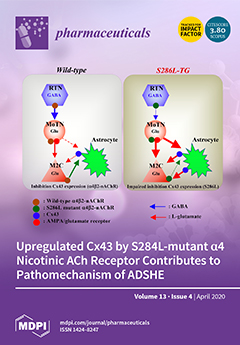The present study was aimed to synthesize silver nanoparticles (AgNPs) from the aqueous extracts of
Odontosoria chinensis (L.) J. Sm. and the synthesized AgNPs were examined for their biopotentials. The
Odontosoria chinensis extracts were added to 1 mM AgNO
3 solution with different
[...] Read more.
The present study was aimed to synthesize silver nanoparticles (AgNPs) from the aqueous extracts of
Odontosoria chinensis (L.) J. Sm. and the synthesized AgNPs were examined for their biopotentials. The
Odontosoria chinensis extracts were added to 1 mM AgNO
3 solution with different ratios viz., 0.5:9.5, 1:9, 1.5:8.5 and 2:8 ratios for the reduction of Ag ions. After reduction, the AgNPs of
Odontosoria chinensis were analyzed spectroscopically for further confirmation. The synthesized AgNPs of
Odontosoria chinensis were characterized by pH, ultra violet–visible spectroscopy (UV-Vis), Fourier transform–infra red spectroscopy (FT-IR), scanning electron microscopy-energy dispersive X-ray analysis (SEM-EDAX) and X-Ray diffraction (XRD). The time taken for the complete reduction of Silver (Ag) in solution to nanoparticle was 10 min. The
O. chinensis aqueous extracts mediated silver nanoparticles showed a broad peak with distinct absorption at around 400–420 nm and confirmed the silver nanoparticle formation. FT-IR results also confirmed the existence of organic materials in the silver nanoparticles of
O. chinensis. The EDX spectra of AgNPs of
O. chinenesis revealed the occurrence of a strong Ag peak. The synthesis of AgNPs of
O. chinenesis was confirmed with the existence of a peak at 46.228°. The toxic potential of AgNPs of
O. chinenesis showed varied percentage mortality with the LC
50 values of 134.68 μL/ 50 mL and 76.5 μL/50 mL, respectively. The anti-inflammatory and anti-diabetic activities of aqueous and AgNPs of
O. chinenesis were statistically significant at
p < 0.05 level. Conclusion: The results demonstrated the toxicity, anti-diabetic and anti-inflammatory potential of the studied AgNPs. The synthesized nanoparticles of
Odontosoria chinensis could be tested as an alternative to anticancer, anti-diabetic and anti-inflammatory drugs.
Full article






